'I'm afraid they're all going to die': Beech leaf disease threatens to decimate RI forests
MIDDLETOWN — When you enter a beech forest and look up at the canopy, the leaf cover should be so dense that you see nothing but green.
When Heather Faubert raised her eyes one recent morning inside Albro Woods, a 9-acre forest in Middletown dominated by American beeches, she mostly saw blue sky.
“It’s heartbreaking,” the University of Rhode Island plant scientist said. “It really is.”
The trees here are stricken with beech leaf disease, and Faubert, director of the Plant Protection Clinic at URI’s Cooperative Extension, expects most, if not all, of them to die.
The disease has torn through a dozen states in little more than a decade, caused by a type of microscopic worm called a foliar nematode that eats the leaves of beech trees.
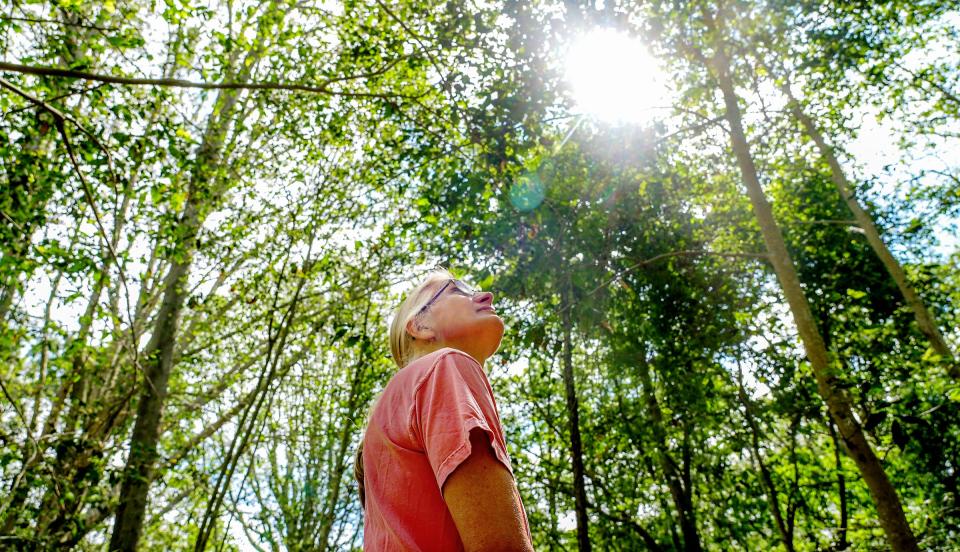
The trees in Albro Woods showed extensive damage. Saplings had been completely denuded of leaves. What leaves remained on many of the older trees had shriveled into leathery curls.
As for any leaves that appeared healthy at first glance, when backlit by the bright sun, they showed the distinctive bands between their veins that the worms leave behind after feeding, the first signs of the disease.
Within a few years, this forest could be decimated.
Beech Leaf Disease isn't the only threat Emerald ash borers are coming for RI's ash trees. Can they be stopped?
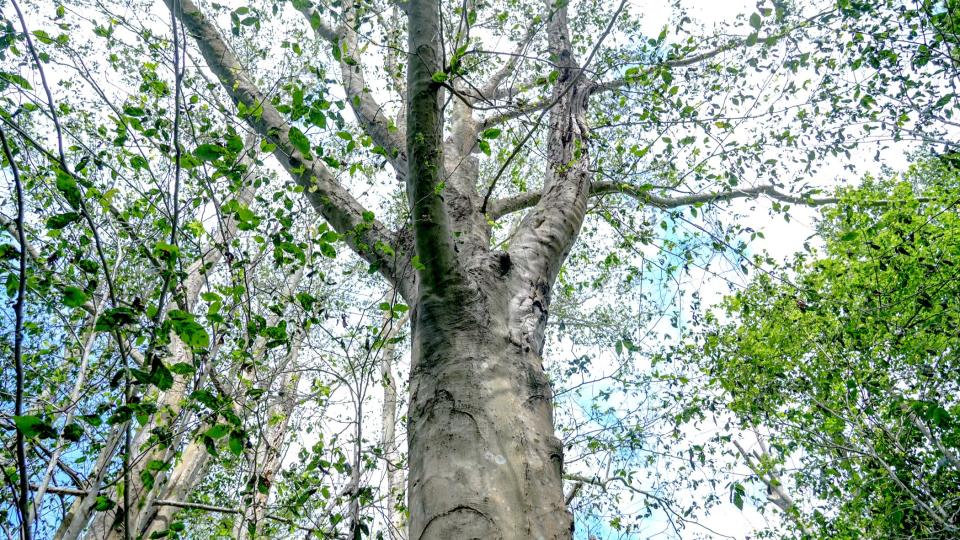
An unmistakable tree in the forest landscape
Whether considering the American native found in forests in the eastern half of the country or many of the European species used for landscaping, beeches are unmistakable trees. Tall and graceful, they’re easily identified by their smooth gray bark that resembles an elephant hide and their long, low-hanging branches.
Exceedingly slow-growing, some American beeches may live 300 or 400 years. They thrive in the shade, eventually reaching the upper canopy by simply outliving other trees in the forest.
Woodpeckers forage in beeches, hawks and owls nest in them, and all sorts of birds and mammals, from deer and chipmunks to blue jays and turkeys, rely on beech nuts for sustenance.
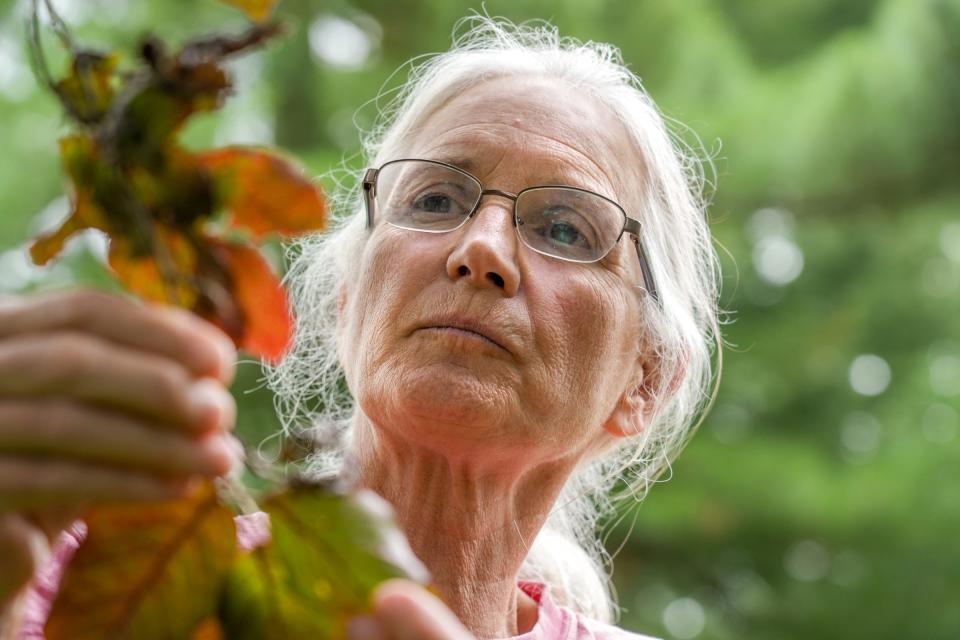
Faubert describes a healthy beech forest as a magical place, shaded by thick foliage, with little undergrowth and a carpet of fallen leaves underfoot.
“Until you’re in a beech forest, you don’t really appreciate it,” she said. “They’re just beautiful, beautiful places.”
Beech trees make up about 10% to 15% of the state’s total forest trees and up to 50% in some areas in Washington County, according to estimates from Fern Graves, forest stewardship program coordinator with the Rhode Island Department of Environmental Management.
The species was not so common in the state in pre-Colonial times. With its thin bark and shallow roots, the beech is more vulnerable to fire than oak, pitch pine or hickory. The tree has benefited from efforts over the last century to suppress wildfires.
Beech leaf disease could reverse that trajectory.
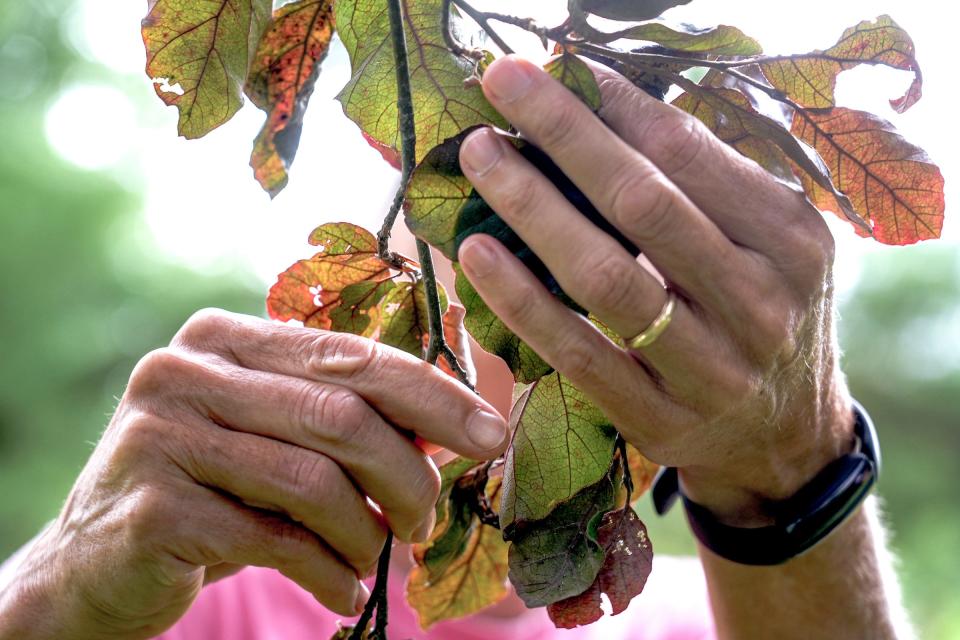
Disease has spread fast since first detection in Ohio
Ohio was the first state to be hit by the disease. That was in 2012. Since then, it has spread as far north as Maine, as far south as Virginia and to parts of all the states in between. It has also been found across the border, in Ontario.
Scientists and arborists are still learning about the disease, but it appears to be so deadly, killing saplings in as little as two years and mature trees in six, that some are worried the American beech could go the way of the elm or the chestnut, which were wiped out in this country by past blights. (There are similar concerns about ash trees, which are being killed by an invasive beetle.)
Faubert discovered the first diseased beeches in Rhode Island in a forest in Hopkinton's Ashaway village in 2020, but they were confined within a radius of only a few miles. Then, in 2021, she found sick beeches on URI’s W. Alton Jones Campus in West Greenwich and in Weetamoo Woods in Tiverton. Last year, she found more in Blackstone Park in Providence and at Blithewold, the coastal estate in Bristol.
Now, she believes the disease is everywhere in the state. That’s borne out by aerial surveys conducted by the DEM. On the most recent in June, Alana Russell, forest health program coordinator for the agency, found irregular tree crowns in many forests.
“I am seeing BLD statewide, basically anywhere beech is present,” Russell said.
The worst-hit areas are in Hopkinton, Richmond and Exeter — around the site of the first infestation.
“This makes sense, as the trees have been stressed the longest in these areas,” Russell said.
More on RI forests: One RI man's quest to find old-growth forests and his mission to protect century-old trees
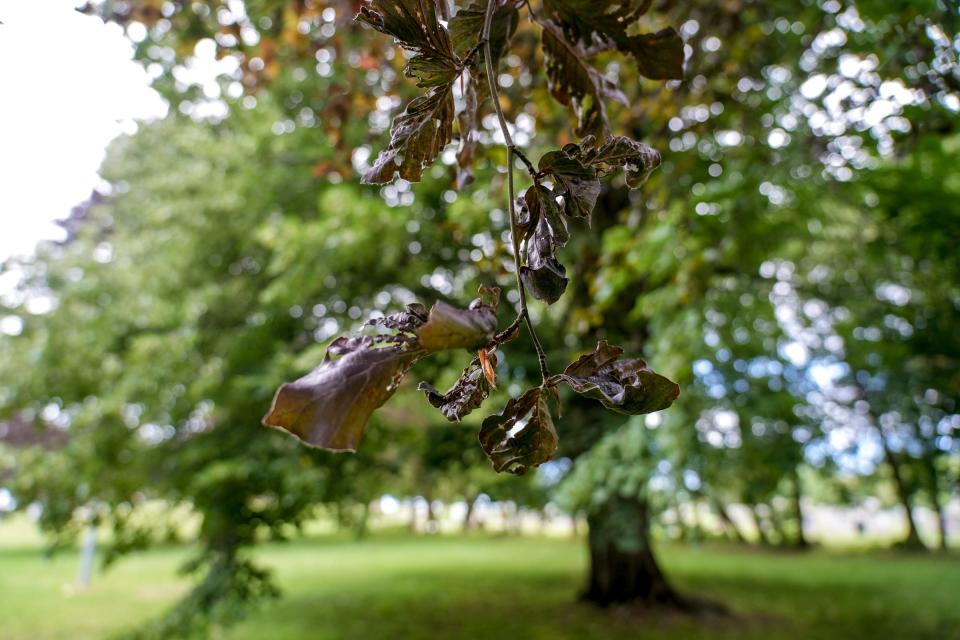
Little is known about the tiny creature that causes the disease
Where the nematode that causes the disease originated is a mystery. A similar species that targets beech has been found in Japan, but it’s unclear if it’s native to that country.
How it got to Ohio is also unclear, as is how it has expanded its range so quickly. One possibility is that it’s being transported by birds, on their feathers or perhaps in their guts. The nematode can survive passage through birds’ digestive systems.
Another possibility is that the nearly weightless worm is simply carried forth by the wind. It may also be spreading through the transport of nursery stock.
What is clear is the threat the little creatures pose. The nematodes overwinter in the long, cigar-shaped beech buds and attack leaves as they develop in the spring. In the first year of infestation, the telltale banding in the leaves appears, which the worms cause by interfering with chlorophyll production. By the second year, the leaves may be crinkled, thick and deformed, or they may not appear at all.
Without functioning leaves, photosynthesis is interrupted, and the tree has trouble producing food.
An infested tree will often generate a second round of often smaller, thinner leaves, but it must tap into its energy stores to do so. A healthy tree can only do this a few years in a row before those stocks are depleted. In time, the diseased tree will more or less starve to death.
The nematodes are tiny, invisible to the naked eye. But they’re so destructive because of their numbers.
When diseased leaves are cut open and wet with a drop of water, the worms are known to swim out. Faubert has counted thousands when studying a single leaf under a microscope.
What's the plan to save it?: Rising seas threaten Bristol's historic Blithewold estate
Landscape trees are also threatened
A trio of European beech trees tower over the cemetery at St. Mary’s Episcopal Church in Portsmouth. As she looked at their leaves, Faubert saw early signs of disease. Without treatment, the trees could soon go the way of the dead they shade.
It’s not just native beech, which are mostly found in forests, that are succumbing to the disease. Ornamental varieties from Europe and Asia, including weeping beech, copper beach, fern-leaved beech and others, are also proving susceptible.
They’re the types of beech you’ll see on the grounds of Newport’s mansions; at Blithewold, which is famous for its specimen trees; or in any number of parks, where visitors like to carve their initials in their bark.
The disease hit American beech first, but it’s now widespread in the European cultivars.
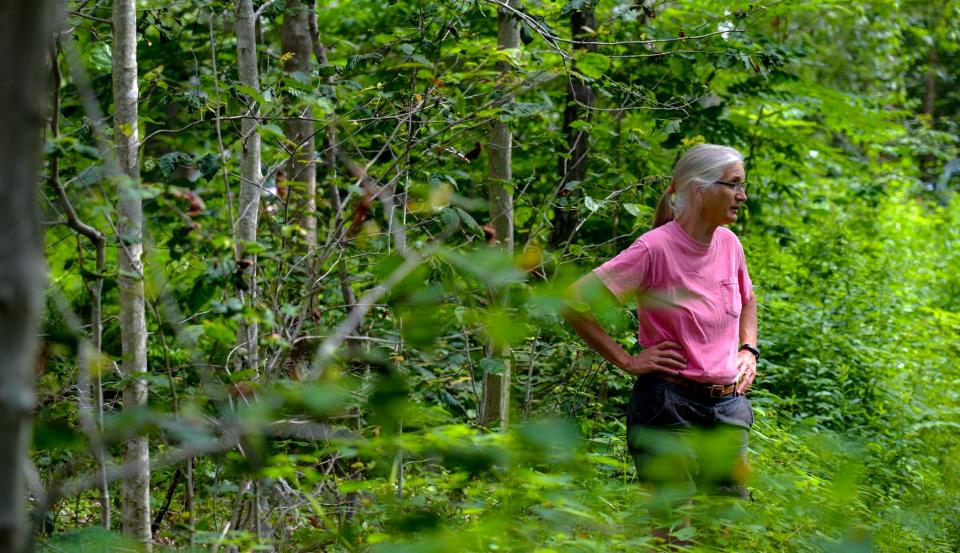
After Faubert wrote an article in April on beech leaf disease, she was inundated with calls and emails from worried property owners. For much of the spring, she was spending two to three hours a day responding to questions about the disease.
“I totally understand it,” Faubert said. “People love their beech trees.”
European beeches are especially prevalent in Newport, where they were planted in parks and on the grounds of Gilded Age mansions on and around Bellevue Avenue. Horticulturist Joe Verstandig estimates there are thousands of the trees in the city.
There were no signs of the disease on Aquidneck Island until 2021. A year later, banding was visible on nearly every beech tree Verstandig came across in Newport.
“It was so fast,” said Verstandig, living collections manager with the Newport Tree Conservancy. “It arrived and then boom, the next year most trees had it.”
In concert with the City of Newport, the conservancy is treating about 50 trees in city parks with a fungicide soil drench that’s aimed at boosting their immune systems.
Arborist Chad Johnson has also tried the soil drench and is testing out a pesticide this summer. He first saw the disease in a red obelisk beech in Jamestown in 2021. Now, he’s treating more than 300 sickened trees at estates in Newport, Narragansett and the Watch Hill area of Westerly. Some of them are 130- or 140-year-old trees standing more than 100 feet tall that are the centerpieces of gardens.
Solar farms are destroying forests: Can RI meet clean energy goals and still protect land?
He believes that spraying the pesticide on leaves in late July, when the nematodes are more active, will be effective, but he can’t promise results.
“We’re in uncharted territory here,” said Johnson, owner of the Cranston-based plant service company GreenerEase. “There’s so much we don’t know.”
He’s optimistic that younger, healthier trees can be treated. So, too, is Verstandig, who’s collecting seeds from around Newport and hoping that some trees will demonstrate a natural resistance to the disease.
If they do, the conservancy will propagate them to help ensure that at least some species of beech will live on in a new generation.
Heat and other stressors are making trees more susceptible to disease
Many beech trees are so vulnerable to the disease because they’re already suffering in other ways.
Hotter, drier summers caused by climate change are putting stress on beech varieties that are known to be thirsty trees. In 2016, 2020 and again in 2022, Rhode Island and the rest of New England experienced drought conditions that the National Oceanic and Atmospheric Administration has described as “historic.”
Beech bark disease, which is caused by the interaction of an aphid-like insect called a scale and a fungus, has also weakened some trees. On the walk through Albro Woods, Faubert found several trees with wooly spots caused by the scale and blisters and cankers that are evidence of advanced progression of the disease.
Nancy Stairs, cooperative forestry program supervisor with the DEM, likens what’s happening to beeches to the destruction wrought by spongy moths (previously called gypsy moths) on maple, oak and other trees in the 1980s and late 2010s.
“You can parallel the impact of repeated defoliation on the beech to the impact of spongy moth — combined with drought and other stressors — that speeds the decline and mortality of the trees,” she said. “But unlike spongy moth, we don’t have biocontrol agents [natural or introduced predators] in the landscape — nematodes are a tough target at the best of times.”
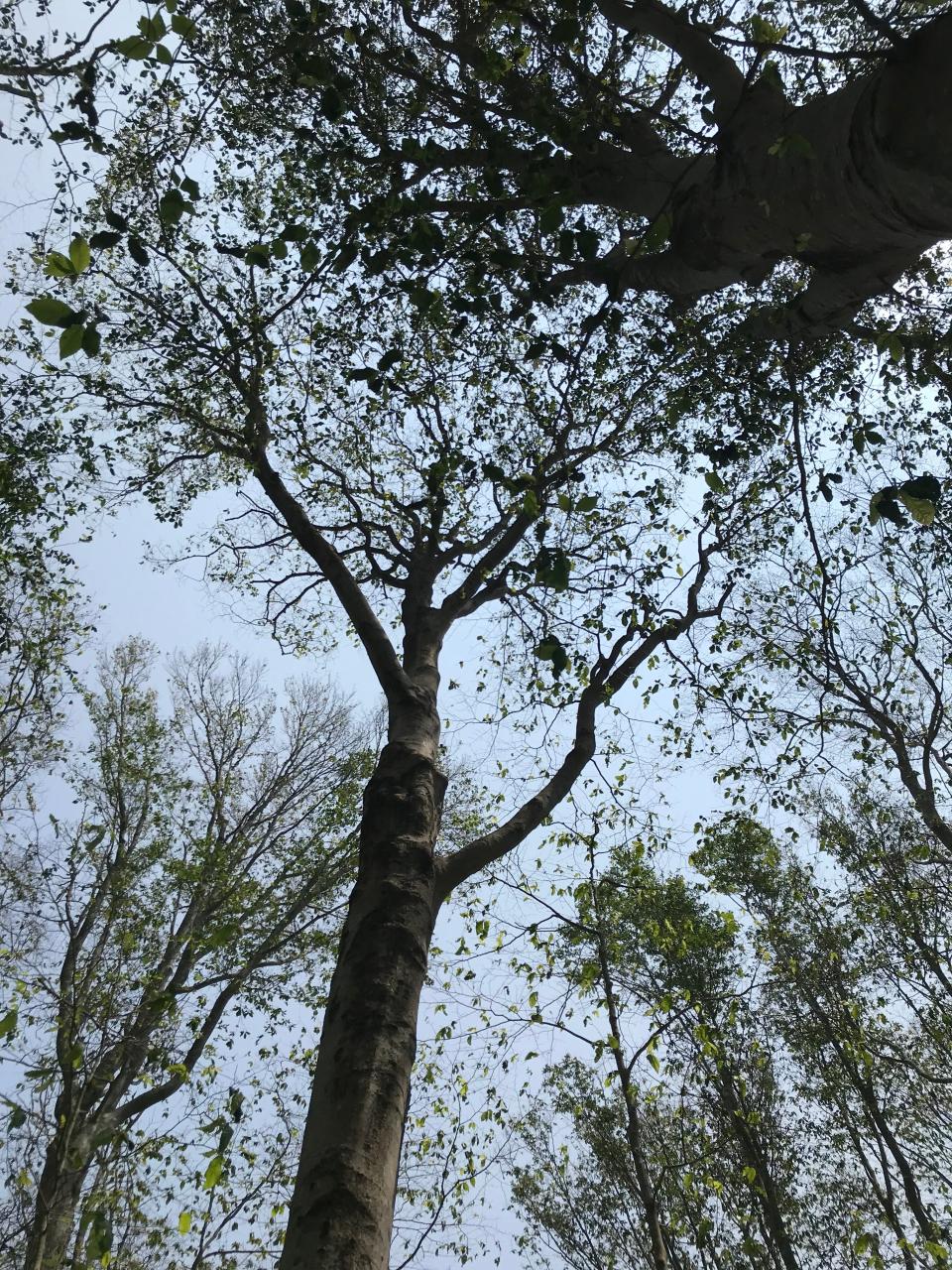
Landscape trees will almost certainly fare better than those in forests, because property owners are willing to spend money on treatments. Still, Johnson worries about older trees that were planted on estates as far back as the mid- to late 19th century, whose immune systems would have weakened over time.
“They coexisted together for most of their lives,” Johnson said of the trees and the mansions. “To lose one or the other would be tragic.”
Verstandig says a tourist who visited Newport before the infestation would see a “startling change” to the city’s tree composition if they were to come back again at the end of this decade. But he’s measured when assessing the effects on the urban landscape.
"It would change Newport’s landscape identity,” he said. “But it’s a landscape that’s always evolving and will continue to evolve.”
He’s more concerned about centuries-old native beech trees like those in Oakland Forest in Portsmouth or in Albro Woods.
“There’s no replacing an old-growth American beech forest,” he said.
Faubert agrees.
“I think it’s going to be devastating,” she said. “I'm afraid they’re all going to die. I'm afraid for our woods.”
This article originally appeared on The Providence Journal: Beech leaf disease, widespread in Rhode Island, threatens forests

